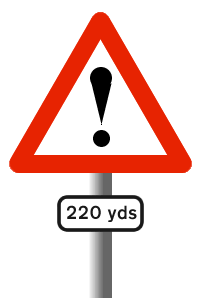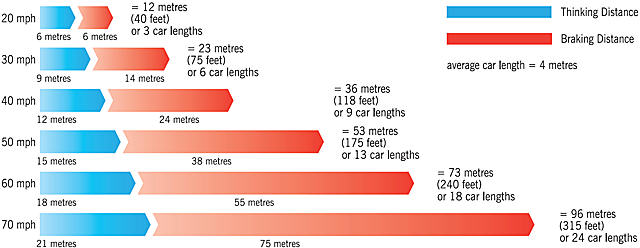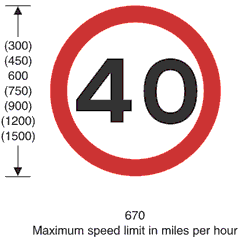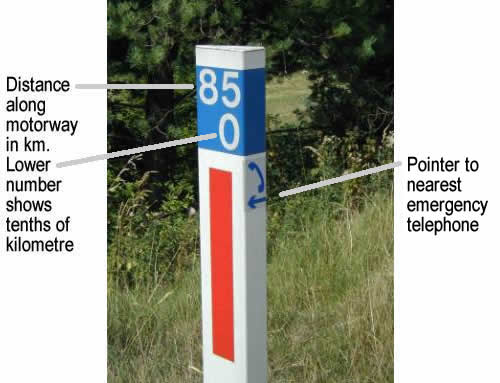A classic example of Britain’s traffic sign mess is the confusing set of units used for distance. A driver needs to understand information provided in a mixture of yards, feet and metres; a real hodgepodge of imperial (yellow) and metric (blue).
| Information | Primary units | Secondary units |
|---|---|---|
| Traffic signs | yards or miles | |
| Stopping distances | metres | feet |
| Visibility information | metres | |
| Highway regulations | metres | feet |
| Road marker system | kilometres |
While motorists muddle through, this is certainly not an ideal situation – especially as metres are suitable for all the situations in the table.
Traffic signs
If distances are indicated on direction signs they are usually shown in miles or fractions of a mile.

However almost all warning signs that indicate a distance use yards. Neither metres nor feet are authorised on such signs.
Stopping distances
A classic example of today’s inconsistent policy is the Highway Code. All motorists are expected to be familiar with the Code and it has a certain legal status.

The Highway Code shows thinking and braking distances primarily in metres with the equivalent to overall stopping distance shown in feet in parentheses. However, illogically neither metres nor feet are authorised for distance signs.
The motorist is at a disadvantage when stopping distances and warning signs used different units of measurement. It would be safer to use metres for both the warning signs and the stopping distances.
Visibility information
The distance to danger is especially important when visibility is restricted by fog or smoke. Meteorologists work in metric, so good visibility is given in kilometres and poor visibility in metres.
Generally speaking motorists only hear about poor visibility – for example a warning that visibility is say less than 100 metres. Such warnings are given on motorists’ reports on the radio and on weather forecasts. Despite this Department for Transport has repeatedly said that it would be confusing for motorists if British distance signage used metres.
Although metres and yards are similar in length, it would be safer and more consistent if visibility and distance signs to danger were both given in metres.
Highway regulations
Almost all underlying measurement information for British roads is metric, despite signage being imperial. Traffic Sign Regulations are a classic example of this.

Although the speed limit is marked in miles per hour, the sign dimensions are specified in millimetres.
The Highway Code also provides examples, for instance paragraph 201 states
“You MUST use headlights when visibility is seriously reduced, generally when you cannot see for more than 100 metres (328 feet).”
Like the case of stopping distances, the motorist is expected to understand distances in round numbers of metres but is confronted with signage in yards.
Similarly Paragraph 217 states:
“DO NOT park your vehicle or trailer on the road where it would endanger, inconvenience or obstruct pedestrians or other road users, For example do not stop…Opposite or within 10 metres (32 feet) of a junction, except in an authorised parking space…”
Paragraph 224 also refers to 10 metres of a junction when referring to night parking. Look at the Road Vehicles Lighting Regulations 1989 for more details.
Incident location & marker system
The continued use of imperial units has resulted in a real lost opportunity for locating emergency incidents. If an accident or other incident is reported to the emergency services it is important that the location is reported accurately. On motorways and major A-roads a system of metric marker posts is placed at 100 metre intervals.

The purpose of these marker posts is to enable the site of an incident to be quickly and accurately located so that the emergency services can get help to the emergency as soon as possible. However, public ignorance of the meaning (or even the existence) of these important safety features seriously hampers their usefulness. As the Commission for Integrated Transport has commented,
“Calls received via personal mobile phones, however, are not linked to any location referencing system that the emergency services are able to access. Therefore detailed information about the road and carriageway affected by the incident will have to be extracted from the caller.
“People often do not keep track of their location to the level of detail the emergency services require. … The public is generally unaware of the road marker system – the Control Room often has to explain what the marker posts are to the caller so that the reference post can then be identified by the caller.”
Public ignorance of the system is probably related to the fact that it is totally metric and hence is incompatible with the imperial to be found on official road signs. We have two incompatible systems: one for professionals and one for general road users. If metric signage was universally adopted the emergency services could benefit greatly from the road marker system.
